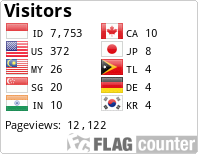IDENTIFIKASI BAKTERI PERNAFASAN PENYEBAB INFEKSI SALURAN PERNAFASAN (ISPA) PADA USIA BALITA DI RUMAH SAKIT BAHTERAMAS
Abstract
ABSTRAK
Infeksi saluran pernafasan (ISPA) adalah penyakit yang disebabkan oleh infeksi akut yang berkaitan dengan infeksi saluran pernafasan termasuk hidung, sinus, tenggorokkan atau pangkal tenggorokkan. Infeksi saluran pernafasan (ISPA) adalah penyebab utama kematian anak dibawah lima tahun. Empat juta anak dibawah lima tahun meninggal akibat ISPA tiap tahunnya dan dua per tiga usia dibawah satu tahun. Dari data rekam medis Rumah Sakit Bahteramas di Sulawesi Tenggara, tahun 2010 sekitar 65 orang terinfeksi ISPA, meningkat di tahun 2011 sebanyak 87 orang, dan menurun di tahun 2012 sebanyak 47 orang. Penelitian ini bertujuan untuk mengidentifikasi bakteri yang menyebabkan ISPA menggunakan swab steril lendir hidung balita di Rumah Sakit Bahteramas Provinsi Sulawesi Tenggara. Identifikasi menggunakan penelitian deskriptif yang diambil dari pasien balita yang terinfeksi ISPA dengan metode accidental sampling. Hasil penelitian dari 50 sampel, telah teridentifikasi 3 bakteri yang menyebabkan ISPA. 5 sampel teridentifikasi bakteri Streptococcus sp.. dengan persentasi 10%, 15 sampel teridentifikasi bakteri Staphylococcus aureus dengan persentasi 30%, dan 30 sampel teridentifikasi bakteri Haemofilus influenza dengan persentasi 60%.
Kata Kunci: Infeksi saluran pernafasan, balita, bahteramas
ABSTRACT
Respiratory tract infection (RTI) is a disease caused by acute infections related to respiratory infections including the nose, sinuses, throat or base of the throat. Respiratory tract infection (RTI) is the main cause of death of children under five years. Four million children under five die from RTI each year and two-thirds under the age of one year. From the medical record data of Bahteramas Hospital in Southeast Sulawesi, in 2010 around 65 people were infected with RTI, increasing in 2011 to 87 people, and decreased in 2012 by 47 people. This study aims to identify the bacteria that cause RTI using a toddler's nasal mucus sterile swab at Bahteramas Hospital, Southeast Sulawesi Province. Identification using descriptive research taken from under-five patients infected with RTI with accidental sampling method. The results of the study from 50 samples have identified 3 bacteria that cause RTI. 5 samples identified Streptococcus sp. Bacteria with a percentage of 10%, 15 samples identified Staphylococcus aureus bacteria with a percentage of 30%, and 30 samples identified Haemophilus influenza bacteria with a percentage of 60%.
Keywords: respiratory tract infection, Toddler, Bahteramas
Additional Files
Published
Issue
Section
License
Authors who publish on JAKK can share their research in a number of ways. JAKK does not impose an embargo on published journals, meaning that researchers can access it openly after the article is published. Researchers who have subscribed to access to articles can also share.
JAKK already uses the Open Journal System (OJS) thereby enabling the final version of all published research articles to be placed in any digital archive immediately after publication. JAKK can automatically make feeds of open access articles available to any repository that wishes to receive them.
Authors who publish with this journal agree to the following terms:
* Authors retain copyright and grant the journal right of first publication, with licensed under a Creative Commons Attribution ShareAlike 4.0 International License (CC BY-SA 4.0) that allows others to share the work with an acknowledgement of the work's authorship and initial publication in this journal.
* Authors are able to enter into separate, additional contractual arrangements for the non-exclusive distribution of the journal's published version of the work (e.g., post it to an institutional repository or publish it in a book), with an acknowledgement of its initial publication in this journal.
* Authors are permitted and encouraged to post their work online (e.g., in institutional repositories or on their website) prior to and during the submission process, as it can lead to productive exchanges, as well as earlier and greater citation of published work.







2.jpg)

